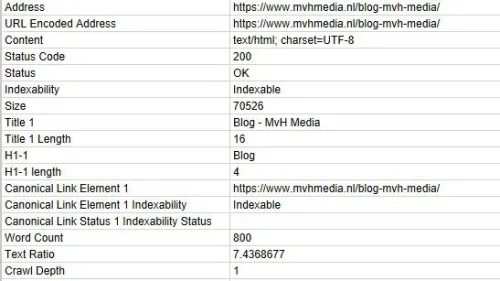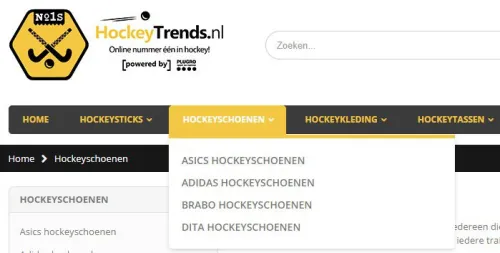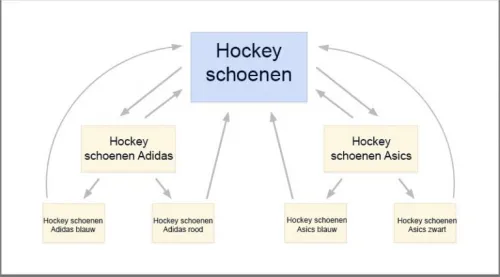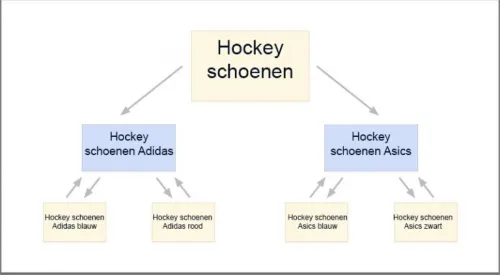The use of internal links remains important. Most websites and webshops understand the importance of external links. However, the use of internal links is often forgotten or proves to be a stumbling block.
Internal links do not yield external links, but they are essential to drive traffic to pages that traditionally attract fewer links or need a much-needed boost in SERPs (Search Engine Result Page). In this blog post, I will discuss creating a good link structure, why you need an internal link strategy, and delve into three different internal link strategies.
How to Create a Good Internal Link Structure?
The internal link structure depends on the goals you have for your website or webshop. However, your website or webshop must always meet the following points for a good internal link structure:
1. Keep the Structure as Shallow as Possible
The fewer clicks needed to go from the homepage to a page, the better. I recommend trying to keep the site structure as shallow as possible. Make the most important pages accessible within two to three clicks from the homepage.
To determine the depth of a particular page, you can use the program Screaming Frog. This tool shows you the click depth per page.

With the Crawl Depth within Screaming Frog, the depth of the page is indicated. So how often you need to click from the homepage to reach the respective page.
2. Add Links to the Main Content of Your Pages
There are two types of internal links, namely navigation links and contextual links. Navigation links are links in the header, footer, and navigation bars to help website visitors visit other pages on your website or webshop. Contextual links appear in the content of your page and have a higher SEO value.
Navigation Links

Contextual Links

3. Include Keywords in the Anchor Text
Use the main keyword in the anchor text. It is also important to ensure that the anchor text informs readers about where the link leads. Using your main keyword as anchor text should not be a problem, as the landing page should be optimized for the main keyword.
4. Limit the Number of Internal Links
Maintain a reasonable number of links on each page. This contributes to user readability and prevents the page from being marked as spam. Also, keep in mind that if you refer to the same URL multiple times on the same page, priority is given to the first anchor text.
5. Ensure Every Important Page is Linked
Search engines can find almost all pages within your website. Even pages that are not linked to any other page. Visitors to your website cannot do this. Therefore, always ensure that your most important pages are also accessible to visitors.
Why Do You Need an Internal Link Strategy?
An internal link strategy helps you achieve predefined goals. Internal links can be a powerful tool. Creating a clear, consistent link structure is a great way to:
- Provide additional and helpful information to your visitor.
- Allow Google and other search engines to crawl your website faster.
- Increase traffic to high-conversion pages with low traffic, such as product pages.
- Promote pages that are stuck on the second page in search engines.
- Improve rankings of keywords with high, medium, or low search volume.
3 Internal Link Strategies
1. Use Internal Links to Rank Important Pages for High Search Volume Keywords

This strategy is used when your website or webshop is optimized for only high search volume and high competition keywords. The keywords often have a generic meaning, such as ‘hockey shoes’.
You need a page designed to attract, convince, and convert people into a lead. The underlying pages have a supplementary purpose. These pages still provide users with useful information, but they should not rank high in terms of search volume.
Your navigation links help your users find content and discover new pages on your website. But most contextual links on your underlying pages should refer back to the ‘hockey shoes’ page via relevant anchor texts.
2. Use Internal Links to Rank Important Pages for Medium Search Volume Keywords

This strategy is used for keywords targeting a medium search volume. These are keywords of about three words with a more specific meaning, such as ‘Hockey shoes Adidas’. They often belong to a product category within e-commerce websites.
In this internal link structure, the category pages have the highest priority. Therefore, the most contextual internal links should refer to these pages.
It is important to link from the homepage to the most relevant category pages. Ensure that the category pages are no more than one click away from the homepage. Also, product pages should link to the parent category page through an anchor text. This is to redirect as much traffic as possible back to the category pages.
3. Use Internal Links to Increase the Relevance of the Lowest Level Pages

This strategy is very interesting when you find yourself in a niche market. With this strategy, you can lead visitors to specific pages at the lowest level, such as specific product pages.
The goal of this strategy is to show visitors the ‘big picture’ that unfolds when buying multiple products. For example, you might have a product page for red Adidas hockey shoes that refers to similar products, such as blue Adidas hockey shoes or blue Asics hockey shoes.
The less competition you have on your keywords, the greater the chance that your pages will be ranked and converted. It is important to make sure that your keywords are being searched for.
Conclusion
It is crucial for your SEO to have an internal link strategy. By adding the right internal links, you ensure that Google and other search engines understand the relevance of certain pages, the relationship between pages, and the value of certain pages.
Need help outlining your internal link structure? The SEO specialists at Follo are happy to help you. Feel free to contact us.
Frequently Asked Questions About
Internal Links and SEO
🚀 What are Internal Links?
An internal link is a link that refers to another page within the same domain. Internal links are often recognizable by colored link text that often indicates what you can find on the page being referred to. This is very useful for visitors, as they can easily navigate within the website to different pages.
💡 How to Create a Good Internal Link Structure?
The internal link structure depends on the goals you have for your website or webshop. However, your website or webshop must always meet the following points for a good internal link structure:
1. Keep the structure as shallow as possible
2. Add links to the main content of your pages
3. Include keywords in the anchor text
4. Limit the number of internal links
5. Ensure every important page is linked
📙 Why are Internal Links Important for SEO?
An internal link strategy helps you achieve predefined goals. Internal links can be a powerful tool. Creating a clear, consistent link structure is a great way to:
– Provide additional and helpful information to your visitor.
– Allow Google and other search engines to crawl your website faster.
– Increase traffic to high-conversion pages with low traffic, such as product pages.
– Promote pages that are stuck on the second page in search engines.
– Improve rankings of keywords with high, medium, or low search volume.
```




